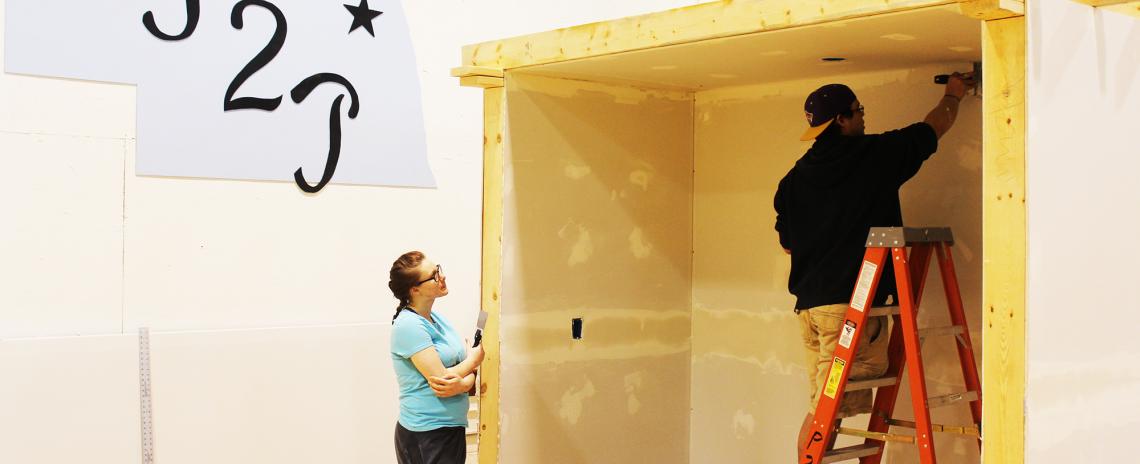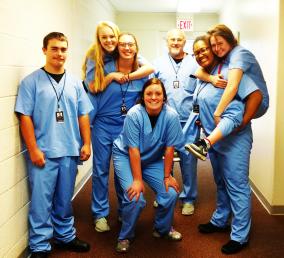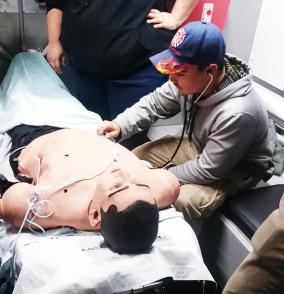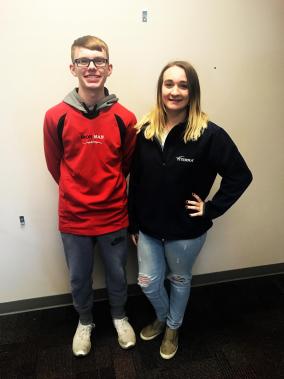Choosing a Path: Familiarized with their fields, ESU 2's P2T students prep for the future
Choosing a Path: Familiarized with their fields, ESU 2's P2T students prep for the future
By Tyler Dahlgren
He’s two months from graduation. Two months from summertime salvation. Five months from college and all of the independence that comes with it.
So forgive West Point High School senior Hayden Schuetze for not sidestepping the “Senioritis” question.
“Definitely,” said Schuetze. “We’re definitely dealing with senioritis a little bit.”
Yes, “Senioritis” is real. Very real. Anybody that’s been through high school can tell you that. But for these two hours, from 1:15-3:15 five days a week, it’s not all that difficult for the computer science student to stay engaged.
In the Pathways 2 Tomorrow program, students are encouraged to set their sights on the future. The future, in fact, is what P2T, an innovative career and technical education readiness program formed by ESU 2 and partners Wayne State College and Northeast Community College, is all about.
So its students think, and even dream, about tomorrow, all the while taking the proverbial, and proactive, first steps towards the rest of their lives.
“I discovered quickly that I really love programming,” said Schuetze, who didn’t sign up for P2T with the intention of finding his calling. “I love seeing what makes a program tick. I love creating programs. I just love that feeling you get when you’re going through a project, hitting roadblock after roadblock, and then you finally make a breakthrough and something starts to work.”
Only a couple of years old, P2T is a consortium of schools that offers secondary career and technical education intended to seamlessly transition its students to post-secondary education, the work force, or even the military. Through partnerships with community organizations, students in P2T receive expanded learning opportunities, including job-shadowing and real-life workplace experience.
Bancroft-Rosalie, West Point, Lyons-Decatur Northeast, Pender, Wisner-Pilger and Oakland-Craig form the six-school consortium, with two districts likely to join soon.
Schuetze found his passion in P2T. For others, like Bancroft-Rosalie senior Kailey Irwin, the program, which is housed in Beemer Elementary School while a brand new building in West Point eyes ground break, allowed the opportunity to explore previous interests more extensively.
“I always had an interest in computers,” said Irwin. “I kind of learned on my own before. I taught myself HTML and then I got into my computer class at Bancroft-Rosalie. They suggested P2T. I came into this class and loved it.”
Growing up, Irwin thought she might want to be a veterinarian. She thought about becoming a psychologist. The job shadowing opportunities given to her by P2T computer science instructor Matt Stansberry put her on a new path.
“I’ve pretty much made up my mind that I want to be a software engineer,” Irwin said. “First, I’m going to go into the military, and then I plan on going to the University of Nebraska at Omaha.”
Schuetze’s experiences in P2T helped him find his path, too. His sights are set on a similar destination.
“Due to me finding a love in programming, I am now going to go into computer science at UNO, and I am trying to find an internship at one of the local programming businesses,” he said. “I want to get my foot in the door and have a place to go work after college.”
Stansberry, who was lured back to Nebraska from Los Angeles to take the P2T teaching job at ESU 2, makes a concerted effort to take his students to various tech companies around the Omaha metro area and Lincoln. Exposure is the goal.
“I want my kids to see what those atmospheres look like,” Stansberry said. “It’s not what you see in the movies, where you go in, clock into your cubicle. It’s not boring, dry and monotonous. A lot of these tech firms, they want you to work hard but they want to reward you as well. They’re going to have snack bars, and they’ll do your laundry and pay for your lunches and all these things that give you incentive to work hard.”
Stansberry has created that same kind of atmosphere in his own classroom, and that’s one of the things his students appreciate most.
“If we didn’t get the field trips that we do, I would think of programming as just a desk job,” he said. “The way he sets up the atmosphere in the classroom is amazing. It’s a good foreshadowing of what things will be like in the real world.”
When Stansberry was coming out of school and looking for a job with a tech firm, he didn’t have the three years of necessary experience. It wasn’t really an option. His students won’t be stuck in that same situation.
“The kids have to get their foot in the door right away during college, even if it’s cleaning the bathrooms at a tech firm,” he said. “We are getting them started now, so that they won’t have that weird delay.”
What he has seen in return from his students is an eagerness to learn. With each project, with each tech company visit, he sees excitement grow.
“They end up almost helping me create curriculum, because they are so excited about what they are doing,” he said.
Stansberry thinks every kid has a desire to learn within them. His job is to provide the spark.
“Every kid wants to learn. Every kid wants to be successful and have these opportunities in life to feel like they’ve accomplished something great.”
***
Dale Mundil’s father was a biology teacher for 40 years, and he followed in his footsteps.
He was an EMT and teaching at West Point High School when an ad for an open instructor position in ESU 2’s P2T program caught his eye.
“I applied, and said ‘Hey, look at the Health Career program we created here at West Point. Does that fit what you’d like to do here?’,” he said. “They liked what we had done, and hired me. We have taken what we did there at West Point and increased it by 100 times.”
Mundil has eight students in his health science courses at P2T, which provides students with the opportunity of becoming Certified Nurses Assistants (CNAs), as well as ample job shadowing time at local hospitals, vet clinics, dentist offices and chiropractic clinics.
The willingness from clinics in the area to become involved has been key to the program’s success. The program relies on its partners and the community, and the partnerships formed are exactly the ones needed to turn a program like P2T from a vision to a reality.
“They have been phenomenal as far as getting our kids in to see everything from surgeries to ingrown toenails to whatever the case may be,” Mundil said. “Our big clinics have been fantastic. We wouldn’t have a program without them.”
When Mundil was in school, he couldn’t have dreamed of receiving the types of opportunities that P2T gives its students. The big thing then was going on a field trip every now and then.
P2T is different.
“The kids are getting two hours every week at a different job, rubbing elbows with doctors and nurses and vets,” Mundil said. “When they leave here, they should have a pretty good idea of what interests them.”
Or of what doesn’t.
P2T lets its students feel out a career prior to committing to another four years of schooling. It decreases the odds of sending a student down a dead-end career path.
Oakland-Craig junior Dacey Nelson was interested in health careers, but being involved in P2T has given her a better understanding of the field.
“I decided I totally want to switch fields,” Nelson said. “Before, I had no idea. I just thought I wanted to be in the health career, and through job shadowing I learned that probably wasn’t the best way to go, so that was helpful.”
For Oakland-Craig juniors Dominick Seery, who went to fire school last weekend, and Jena Gardeman, have seen their career paths become a little bit clearer thanks to P2T.
“I went to a job shadow and helped the nurses deal with a mother that had given birth an hour before I got there,” Gardeman said of her most memorable experience. “I helped clean her up and was able to take care of the baby.”
Mundil’s eight health science students anticipate growth in the coming years. They’ve fielded lots of questions from interested students at their respective schools, and even went on a “P2T Roadshow” with residential construction and computer science students to share their insights.
“The Roadshow was really cool,” said Wisner-Pilger junior Jordan Wegner. “We were able to go to all of the schools and talk about our experiences, and that just caught their eye. For the next week I was answering questions about P2T.”
For Mundil, it’s neat to watch students from different schools interact and, in many cases, become friends.
“In this building, we don’t have a ball team or a mascot or anything like that,” he said. “It is neat to see how they have gotten along and interacted with one another. They’ve become friends. It is cool to see.”
***
The elementary gymnasium down the hall has been transformed into a shop, where David Hughes’ residential construction students are hard at work fixing drywall.
Hughes was at West Point for 35 years in total, heading a Trades and Industry program for the final 30 before accepting a job with P2T.
“I think P2T and ESU 2 have done a really good job pushing this program the last two years and getting this thing rolling,” Hughes said. “We had to come in and build everything from scratch. We’re still not completely done, but you work with what you’ve got.”
Soon, Hughes and his students will be working with a whole lot more.
The new facility in West Point will be more accommodating than the one P2T students are currently in at the Beemer Elementary building, but they’ve still accomplished plenty the last two years, including the construction of a new garage behind the school and a 10-hour OSHA training session that ended with each student receiving his or her OSHA card.
“I want the kids to be able to walk out, and when they become consumers I want them to be comfortable doing whatever they need to do around their own homes,” Hughes said. “If they want to go on to a tech school and specialize in a specific area, great. If they want to go to college and pursue engineering, great.”
When students leave P2T, they are headed straight for the future.
Hughes said it best.
“The kids have pathways now.”





